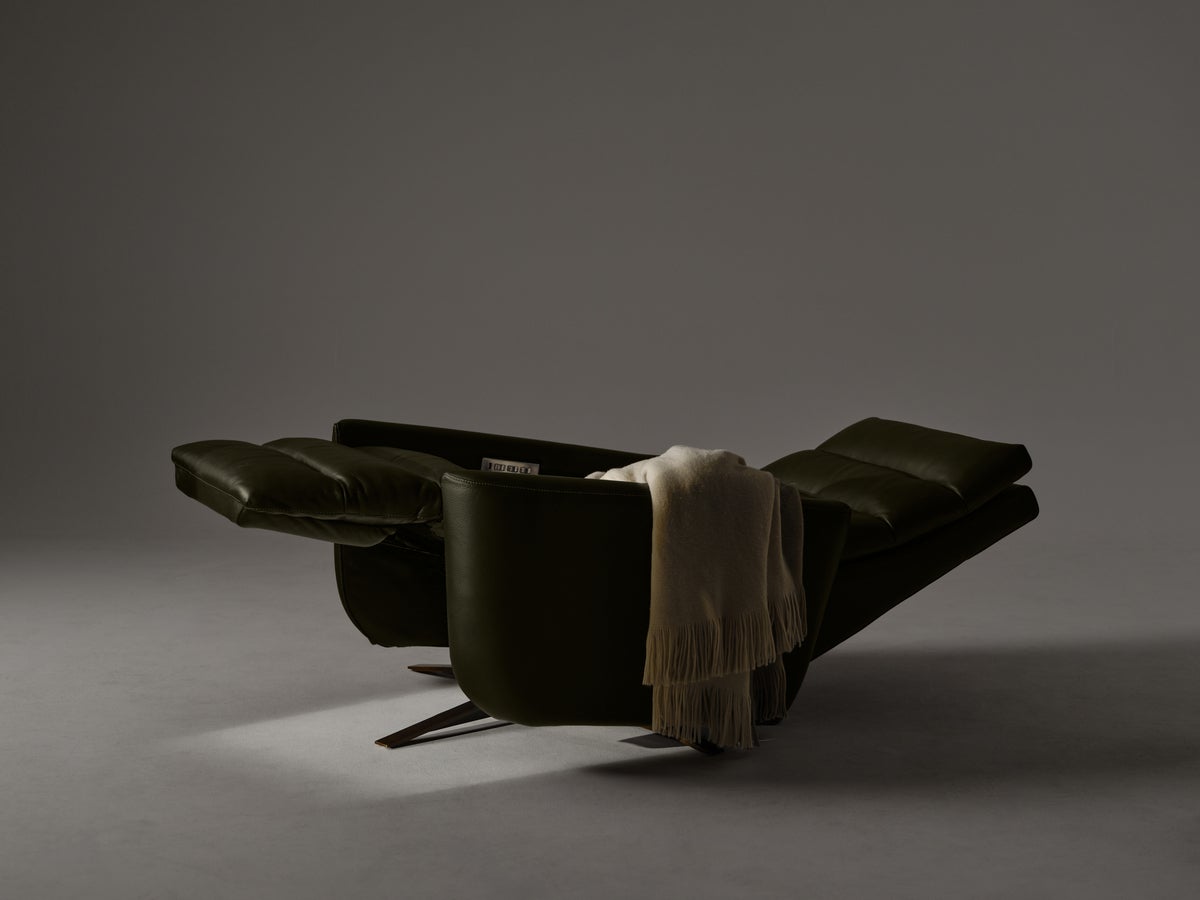If anyone ever offers to take your picture while you’re in a recliner, say no. I learned this lesson the hard way, in the showroom of a high-end European furniture brand, stretched out in a sleek leather chair almost horizontal to the ground. The sales associate meant well, but the photo captured me at an angle politely described as “unflattering” and more accurately described as “horrendous.”
The photo embodied the essence of a classic dilemma in the design industry: Let’s call it the recliner problem. On the one hand, recliners seem to get more and more comfortable with each year—and comfort is increasingly what consumers want out of their homes. On the other hand, recliners have long struggled to shake the idea that, frankly, they’re not particularly cool.
Much of that stigma comes from what is colloquially known as a “Bubba” chair, the overstuffed brown leather recliner designed to partially ingest a male body for the duration of a football game. These chairs are unapologetically ugly. But even as recliner design got sleeker around the turn of the century, the bad reputation has stuck.
The recliner problem is often expressed in terms of gender. The cliché: Women hate them, men insist on them (hence the rhyme, passed from sales rep to sales rep: “Wives and designers don’t like recliners”). It’s a difficult hypothesis to test, but the idea is baked into the way the industry makes and markets recliners.
Inherent to that challenge is an opportunity: If you could design a recliner that everyone liked, think of the units you could move. Indeed, just as old as the problem is the idea that we’re on the verge of a solution. As far back as 1977, The New York Times ran an article in which a Barcalounger exec admits, “Historically, interior designers have hated recliners.” The author goes on to suggest that some new models from the company might reverse the trend.
Spoiler alert: They didn’t. But there are recent signs in the marketplace that motion furniture is breaking through with customers who long shunned it, which begs the question. Is humanity—after mapping the genome, photographing a black hole and incubating artificial intelligence—finally ready for a real challenge, like a solution to the recliner problem?
A DEMAND FOR INNOVATION
Anders Larsen and David Workman make for a fun hang. Larsen, the VP of product development at American Leather, is a tall, cerebral Dane who can casually riff on the physics of a footrest. Workman, the Kirk to Larsen’s Spock, is outgoing and speaks fluent furniture with a Southern drawl. As executive vice president of sales, part of Workman’s job is to market the recliners that Larsen engineers. The two have good chemistry—their contrasting accents give them the vibe of a comedy duo.
Earlier this spring I spent an afternoon with them at American Leather’s factory in Dallas, learning more about recliners than I ever thought there was to know. I sat in the company’s gravity-powered Comfort Air rocker—technically not a recliner, though it looked like one—that relaxes and straightens in response to the body’s movements. I saw the testing room where Larsen’s staff straps gym weights to chairs to vet their safety. And I learned that in the language of recliner design, Bubba is an adjective.
Much of our conversation was focused on technical details: how to hide the telltale flaps that often cover the rear of a reclining seat; why some “mechs”—the industry term for the metal skeleton inside a recliner that makes it expand and contract—are better than others. But lurking behind that were the needs of the market.
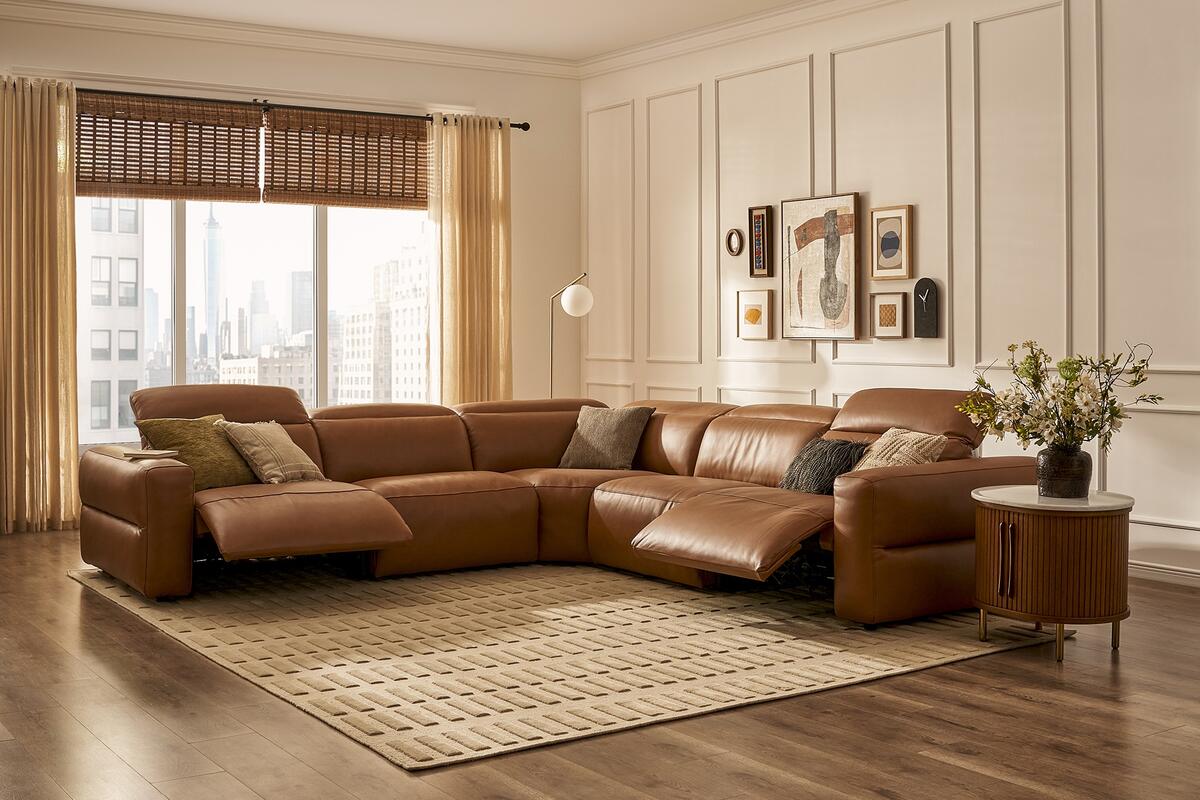
American Leather is a difficult company to define: A vertically integrated operation, it manufactures white-labeled upholstery for well-known retailers like RH and Design Within Reach as well as producing its own line. Perhaps the company’s most recognizable hit is its sleeper sofa, but as Larsen and Workman made clear, recliners—and motion furniture more broadly—have become a bigger slice of the pie, with the category’s sales growing in double digits over the past three years.
Larsen attributed some of the company’s success in the category to its ability to navigate the narrow lanes drawn by the classic dilemma: making a recliner that looks less like a recliner than other recliners. “People want to be comfortable, but our typical customer also says, ‘I don’t want it to look like motion.’”
“The biggest request for me from larger-scale private-label customers is how do you make an accent chair, like this, with motion?” Workman said, pointing to one of the company’s petite, boucle-adorned stationary chairs. “I’m talking about something that has a lot of the rounded shapes, that looks like a classic swivel chair, but with motion—it’s very difficult, but we’re looking at ways to put a mechanism in that doesn’t throw off the aesthetics.”
“It’s the fastest-growing category in furniture,” he added, with a knowing look. The numbers back him up: a recent study claims that the motion category made up one-third of all U.S. upholstery sales in 2023, and the number is trending up. A more recent survey in Furniture Today identifies motion upholstery as the rare area of growth for furniture retailers amid a gloomy overall market.
Why are recliners having a moment? As is often the case when tracing the origins of a design trend, there are a lot of theories, none of which feels completely satisfying. The most common explanation I heard was simply “Covid”—the idea today’s recliners are a response to the pandemic’s demand for comfort at home.
Another was basic demographic math. The two largest living generations in the U.S. are millennials and baby boomers. Boomers are retiring in droves and on the hunt for comfort. Millennials, meanwhile, are cruising into their 40s and nursing their first lower-back problems—but want something Instagram-ready. These two demographic “bulges” create a demand in the marketplace that shows up as a flurry of recliners.
Gabriele Natale, the president of Manwah USA, one of the largest motion furniture importers, suggested a simpler explanation: Motion is hot because unlike a lot of other furniture categories, it has actually gotten better. “If you look at where it was 15 years ago, motion was an ugly dog, but it has evolved a lot in design and functionality,” he says. “Stationary has not.”
Given the industry’s focus on design, it can be easy to forget that—much more than other categories—motion furniture is a technology. And like all technology, it tends to improve over time. Mechanisms get lighter. Motors get quieter. Just as importantly, prices go down.
Recliner technology can cut both ways. There has been a historical tendency for manufacturers to glom on to whatever the tech industry is peddling at the moment and put it in a chair. At American Leather, Larsen and Workman laughed at the trends that have come and gone. “My favorite was Bluetooth, where you had an app to open up the chair,” recalled Workman.
At its most baroque, recliner technology becomes pure self-parody. La-Z-Boy’s 1999 Oasis chair came with a massager, a heating element, a telephone, and a cooler that could hold a six-pack of beer. In today’s market, there’s a certain strain of reclining massage chairs, decked out in sleek metal and plastic, that resemble Transformers about to change into robot form.
That recliners are technology also makes them more time-consuming and expensive to develop. American Leather, which built its Comfort Air line from scratch, spent almost four years bringing the model to market. The company is somewhat unusual among manufacturers in that it will often collaborate with outside manufacturers to develop a bespoke mech for its recliners instead of buying them out of the box.
Working that way allows Larsen and his team to develop unique chairs. But it necessitates a fairly onerous testing regimen: strapping weights to a recliner to simulate body weight, turning the chair on, and letting it open and close 25,000 times. The process takes three weeks, and adds a considerable amount of time to an already complicated process. “We run it with five cameras, 24-7,” said Larsen. “Sometimes we’ll be looking at the video on our phones on Sunday afternoon. If it fails, we have to fix it and do the whole thing again.”
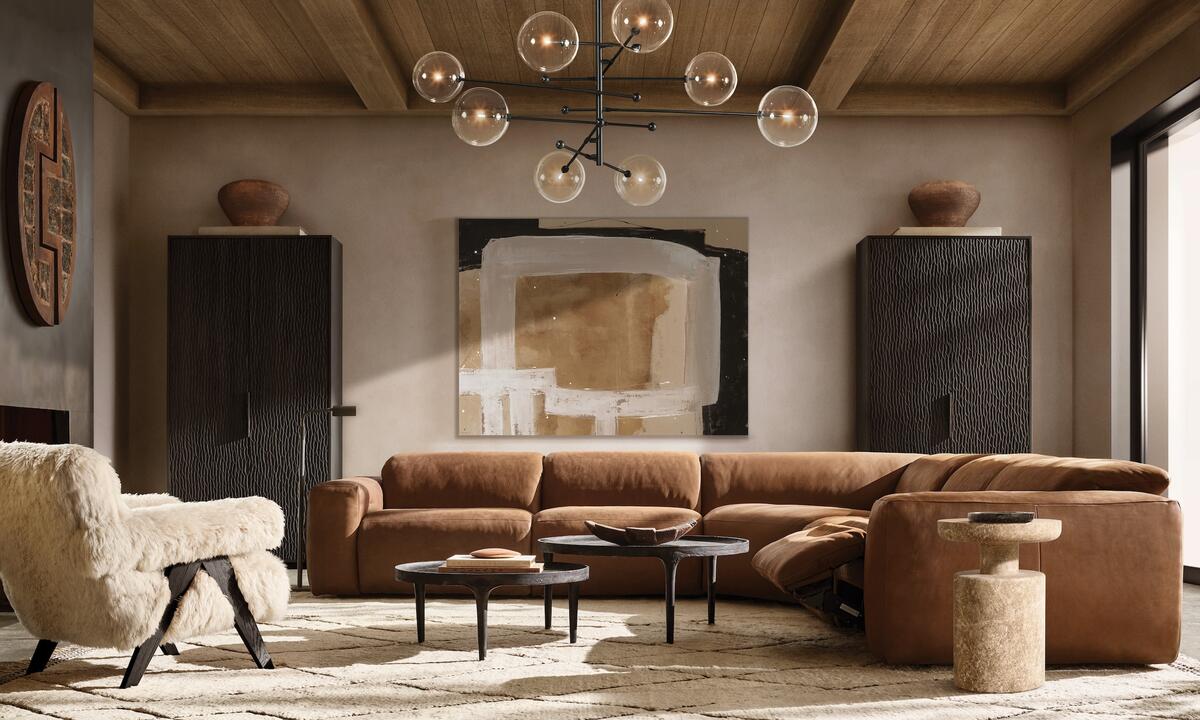
WINNING OVER THE SKEPTICS
Recliners have long been winners in the mass market. A little more surprising is the fact that motion is popping up in corners of the market where it once might have been verboten. You still won’t find a ton of power recliners at Thomas Lavin, but manufacturers who cater to high-end retailers and designers directly are dabbling with the category more and more. Even RH debuted a line of power-motion sofas and chairs last fall.
Another case in point: This spring at High Point Market, Rowe debuted recliners for the first time in the brand’s nearly 80-year history. “We’re a company that had kind of chuckled at recliners, but it’s insane how much business is done in the category,” says the brand’s president, Bobby Robinson. “The consumer has spoken, and they want it.”
Like many in the industry, Robinson framed his company’s efforts as an attempt to hack away at the classic recliner problem. “Often, there’s a negotiation, where [the husband in a couple] will say, ‘Honey, I want a recliner,’ and designers are left grappling with that,” he says. “How do we come to market and give them the opportunity to fully execute their vision, and not, at the end of the process, have something that doesn’t really fit. … [Giving them] that bit of texture, color, pattern, aesthetic that works with everything—that’s where we saw a white space in the market.”
While American Leather’s approach is rooted in engineering, Rowe’s entrée into the marketplace was more about staying true to its brand voice. Most of its motion pieces are slight modifications of chairs that are already a hit with designers. Interestingly, getting the same look—but making it recline—required an entirely different manufacturing approach, with new vendors and a new supply chain.
“We can develop a sofa in our sleep. But there was a lot that we had to learn as we developed these—like a fish out of water,” says Robinson. “But we learned a lot, and designers are asking for this.”
Surya was another brand that introduced a recliner at Market this spring, with a chair created by a designer, Becki Owens. CEO Satya Tiwari isn’t planning on diving into the category headfirst, and is skeptical that it would ever make up a huge percentage of his company’s trade business. But enthusiasm in the marketplace made it seem like a worthy experiment. “We had a lot of success with swivel chairs at Mitchell Gold [which Surya acquired in 2023], so we knew motion mattered. We thought, ‘Hey, let’s try one,’ and it got a great response at Market,” says Tiwari. “Now we’ll see how it sells.”
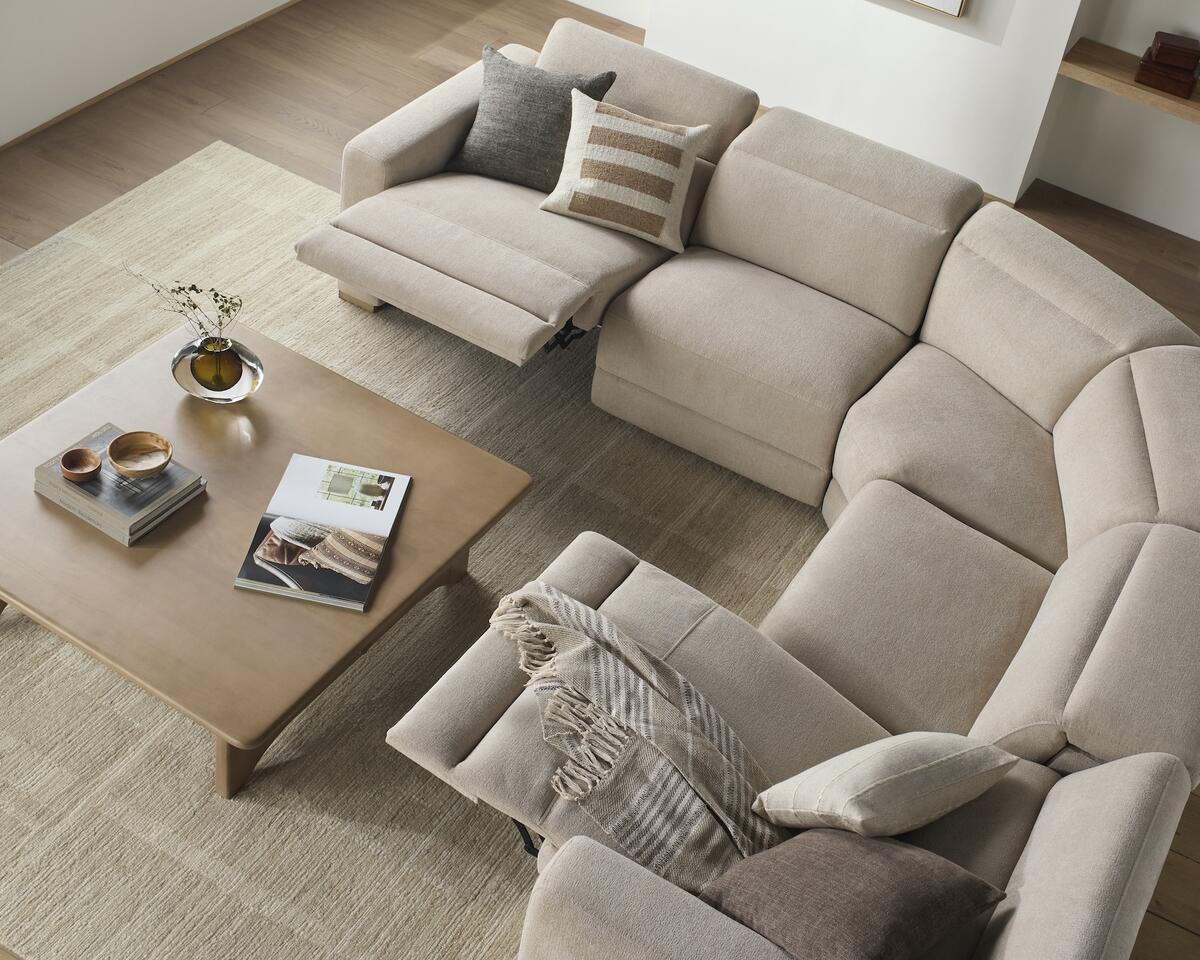
A DIMINISHING STIGMA
If designers represent a tough audience to win over, there’s another demographic that may be even tougher: young people, the final boss of recliner skeptics. It’s no secret that an older audience drives the market for recliners, as seen in market studies as well as anecdotal evidence. Many brands told me that designers with a Gen X or boomer client base are an easier sell, and that they often get pushback from a younger crowd.
However, cracks are appearing there as well, notably among startups that are running the DTC playbook and flooding Instagram with recliners. Homebody is one of them. In 2023, entrepreneur Zelong Zhao launched the company, taking advantage of his family’s furniture business in China as a manufacturing base. His thesis: If you could create solidly functional motion furniture that looks stylish at rest, you’d have a product. If you could market it to the rising generation, you’d have a brand.
CMO Jessica Hann is aware of the challenges. “You do kind of associate [recliners] with being in your grandparents’ house. There’s also the functionality element, where people who are frail or don’t get around as much anymore want something that helps them,” she says. “It’s got kind of a stigma.”
For Homebody, the way around the recliner problem is partially tapping into a preapproved aesthetic (the company’s bestseller is a motion couch that resembles RH’s Cloud sofa). But it’s also simply showing the product in action. Surprisingly, for a category that struggles to shake the association with an older generation, motion does well on young people’s media of choice: Instagram Reels and TikTok. Unlike stationary furniture, recliners do something.
“Social media is great for us, because the content there is basically all video now,” says Hann. “It’s about surprise and delight: It’s not a recliner! No, it is a recliner! And it surprises people.” Unsurprisingly, Homebody’s social feeds are full of stylish young people using their product. However, even with a brand targeting the next generation, clichés die hard. A recent Instagram video is captioned: “You’re ready to admit your husband was right about recliners.”
Castlery is another DTC brand that has put serious thought into the way motion shows up online. The Singapore-based company, founded in 2013 by entrepreneur Declan Ee, has built a whole-home brand selling into Asia, Australia and the U.S. But it wasn’t until this year that Castlery got into motion.
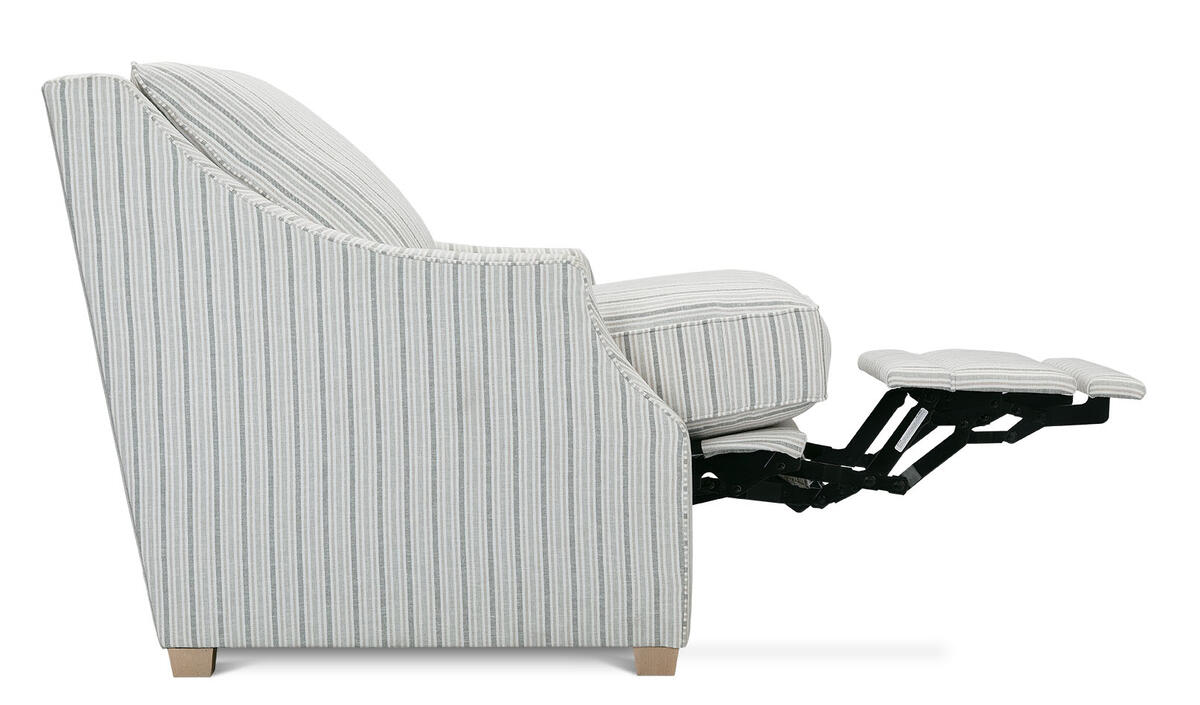
“We always wanted to do it, but it was about responding to customers,” says Ee. “There was a request from various customers that we should do this—myself included—saying, ‘I want a good-looking sofa, but I need to lay back.’”
A common strategy for making a recliner not look like a recliner is to slim it down and go for a modern, trim silhouette, an approach probably best embodied by DWR’s perennial bestseller, the Flight recliner, first introduced in the early 2000s (the designer, Jeffrey Bernett, had just come off a gig making seating for Delta Air Lines). Castlery’s team took the opposite approach, creating a marshmallowy line, Jaron, that gives Bellini, not Bubba.
“We wanted something that's very plush, hugging the customer,” says Ee. “The second [challenge] which is unique to us because we are online only, is how do we create something that is visually appealing and visually comfortable online?” To that end, his team added plushness where the recliner technically doesn’t need it: on the side arms. The padding doesn’t do anything to make the user feel more comfortable—you’re not sitting on it—but it conveys comfort on the small screen.
Since Castlery launched Jaron in March, the line has quickly become a top-five bestseller, and Ee is already working on the brand’s next motion launch. Once an industry punchline, recliners are an increasingly serious business. Are they, at long last, cool? Designers will be the judge.
















